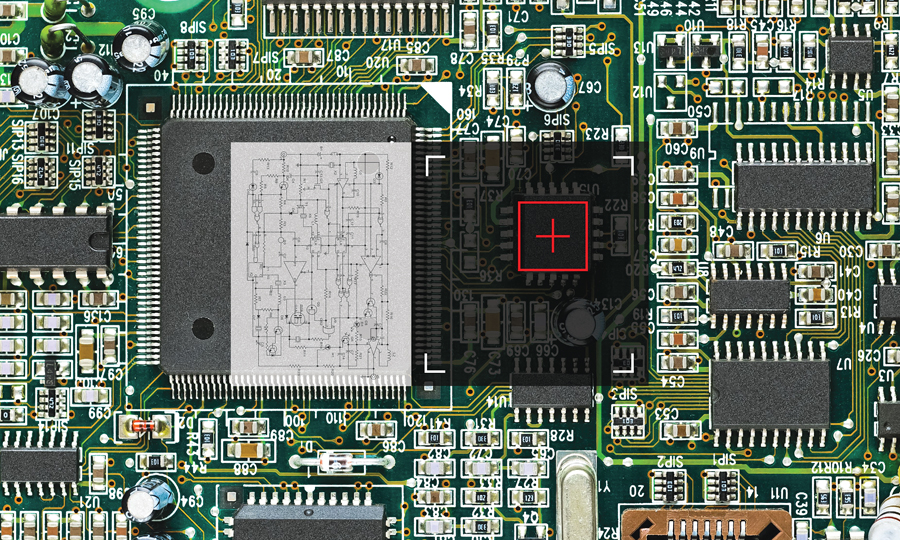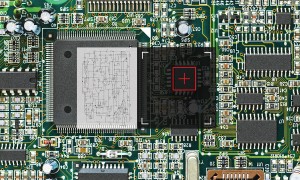
Enhancing the maintenance vision
Walking along the factory floor, I spotted the telltale signs of a water leak: fluid on the floor. “OK Glass, create a work order. Issue description: water pump leak.” That’s a future scenario for a maintenance technician...
February 1, 2014 | By By Dr. Jeffrey Dutschke
 Glass can display a schematic diagram as a technician examines a circuit board. Image design: Jamie Lipson
Glass can display a schematic diagram as a technician examines a circuit board. Image design: Jamie Lipson 
Glass can display a schematic diagram as a technician examines a circuit board. Image design: Jamie Lipson
Walking along the factory floor, I spotted the telltale signs of a water leak: fluid on the floor. “OK Glass, create a work order. Issue description: water pump leak.” That’s a future scenario for a maintenance technician using Google Glass, a set of eyeglasses that contain a computer, voice recognition technology, a display, and enough smarts to help you keep track of everything you need.
Google Glass basically is a portable computer worn like a pair of glasses. It makes accessible, without being touched, a camera, microphone and speaker, with WiFi and Bluetooth communication. A Glass wearer can communicate with the Glass using voice commands and touch gestures on a touch pad.
For example, to initiate a voice command, wearers speak to the Glass, “OK Glass,” they’ll say, followed by a command. In return, Glass communicates to the user with a bone-conducting speaker and a heads-up display positioned above the right eye. Using the camera, the wearer can take photos and record videos and send them to others.
Like a modern smartphone, Google Glass wearers will be able to download apps to make full use of the functionality in the device. And this is especially interesting: apps for maintenance and repair will be among the first to be developed.
Already, Google Glass is starting to make an impact in some professions. In June 2013, a surgeon performed a knee operation for the first time wearing Google Glass. Hundreds of medical professionals watched the live stream captured by the Google Glass camera, learning from his experience. Maintenance and repair teams will also see remarkable innovations like this when using Google Glass.
See maintenance differently
Google Glass provides a great opportunity to revolutionize the way humans interact with their computers. When dedicated maintenance and repair applications are developed, the wearer will directly connect to the maintenance database and do all of the usual maintenance activities − and more.
Even without a dedicated maintenance and repair application, many maintenance activities will be greatly improved using the hands-free nature of Google Glass. The fun part, however, is imagining the possibilities for the device when dedicated apps are developed, thereby making Google Glass a necessity for maintenance and repair technicians.
Today’s applications
For the maintenance technicians of today, Google Glass technology will easily integrate with their day-to-day work activities. When Google Glass is fitted with a protective lens, maintenance technicians will be able to directly substitute them for their regular safety glasses. But there is much more to this technology than some expensive personal protective equipment.
Already, normal SMS, Twitter and e-mail messages can be read on the heads-up display of Google Glass. Instantly, this makes the device an ideal way to receive work orders sent via e-mail or text message.
More than that, the device is also a video telephone. This provides some exciting possibilities for maintenance technicians. The camera can be used to get help when diagnosing a fault, either from a more experienced technician or from the help centre of the equipment manufacturer. For apprentices, this will be an amazing way of interacting with their boss and getting advice while on the job.
For the maintenance and repair people who are first to adopt Google Glass, they will be provided with a great amount of functionality. The revolution of maintenance will only begin, however, when dedicated maintenance and repair applications are developed for them.
Tomorrow’s applications
When CMMS vendors develop applications that run on Glass, the future maintenance and repair applications for Google Glass are endless.
Using QR codes on asset label plates, technicians will be able to access the equipment record directly. Voice commands will become commonplace in maintenance. “OK Glass” will start, followed by “submit work request,” “complete work order,” “view previous work orders,” “add photograph,” or “add video.” No pen or keyboard will be required to type out and record maintenance data, as it will be done with speech-to-text recognition.
Procedures and labour tasks for maintenance will be shown on the heads-up display as the technician works. When he or she needs it, staff will be able to access digital information for the equipment on which they are working, while they are working. Details such as schematics, bill of materials and safe operating procedures will be able to be viewed. Imagine looking at a circuit diagram whilst in a dark and confined space, fixing the actual circuit. It will be possible with Google Glass.
Drawing from the example of the surgeon, procedural videos recorded by experienced technicians will be attached to the asset using a CMMS system and will be viewed by another technician doing the same job years later.
Here are some other benefits of using Glass in maintenance.
Direct communication to equipment: During the execution of a work order, information from diagnostic machines will be delivered to the Glass via Bluetooth. Data from sensors attached to the machine, such as amp draw, speed and vibration could be made visible on the Google Glass.
Imagine the improvement in work flow if the heads-up display showed the results of a laser shaft alignment procedure or electrical testing details as you shift the multimeter probes across the circuit. All of this information could then be uploaded directly and in real time to the maintenance system.
Fast parts identification and reordering: As new parts are being installed during the work, their QR codes can be scanned with the camera, and the part automatically shown as consumed in the work order. Its costs will be accounted for, and replacement stock ordered from the supplier. Defective parts will be quickly scanned and replacements ordered from stores.
Digital machine lockout: In advanced facilities, the unique serial number of the Glass will provide the hardware for an electronic lockout procedure. Everyone with Glass could individually lock out a machine, and only when everyone had individually electronically unlocked the machine could it be made operational. At the same time, this process could provide an auditable and enviable safety record.
Advanced data capture: Furthermore, because Google Glass makes the process of gathering and recording information easy, this additional data can revolutionize the way planning and purchasing for maintenance operations occur. This will make significant cost savings possible.
How far away is this future?
Up until now, Google Glass has only been available in limited quantities to selected users, but it has been reported that Google Glass will be released for public sale in 2014. Maintenance-specific functionality will only become available when CMMS and EAM software developers develop the required apps.
Already, innovative companies like Maintenance Assistant are incorporating this device into their software plans, so it would be reasonable to expect that dedicated apps will be available before the beginning of 2015.
To make full use of the Google Glass functionality, you will need an innovative CMMS or EAM solution that supports the device. Making the transition to an innovative solution early will make for an easy transition to Google Glass when it becomes available.
Technicians will love the functionality. Engineers and accountants will appreciate the data provided, and management will love the potential cost savings. Perhaps the time is right to plan for you to plan your adoption of this technology too.
Dr. Jeffrey Dutschke is an industry research specialist and blogger at Maintenance Assistant, a provider
of web-based CMMS software. Visit www.maintenanceassistant.com for more details.
